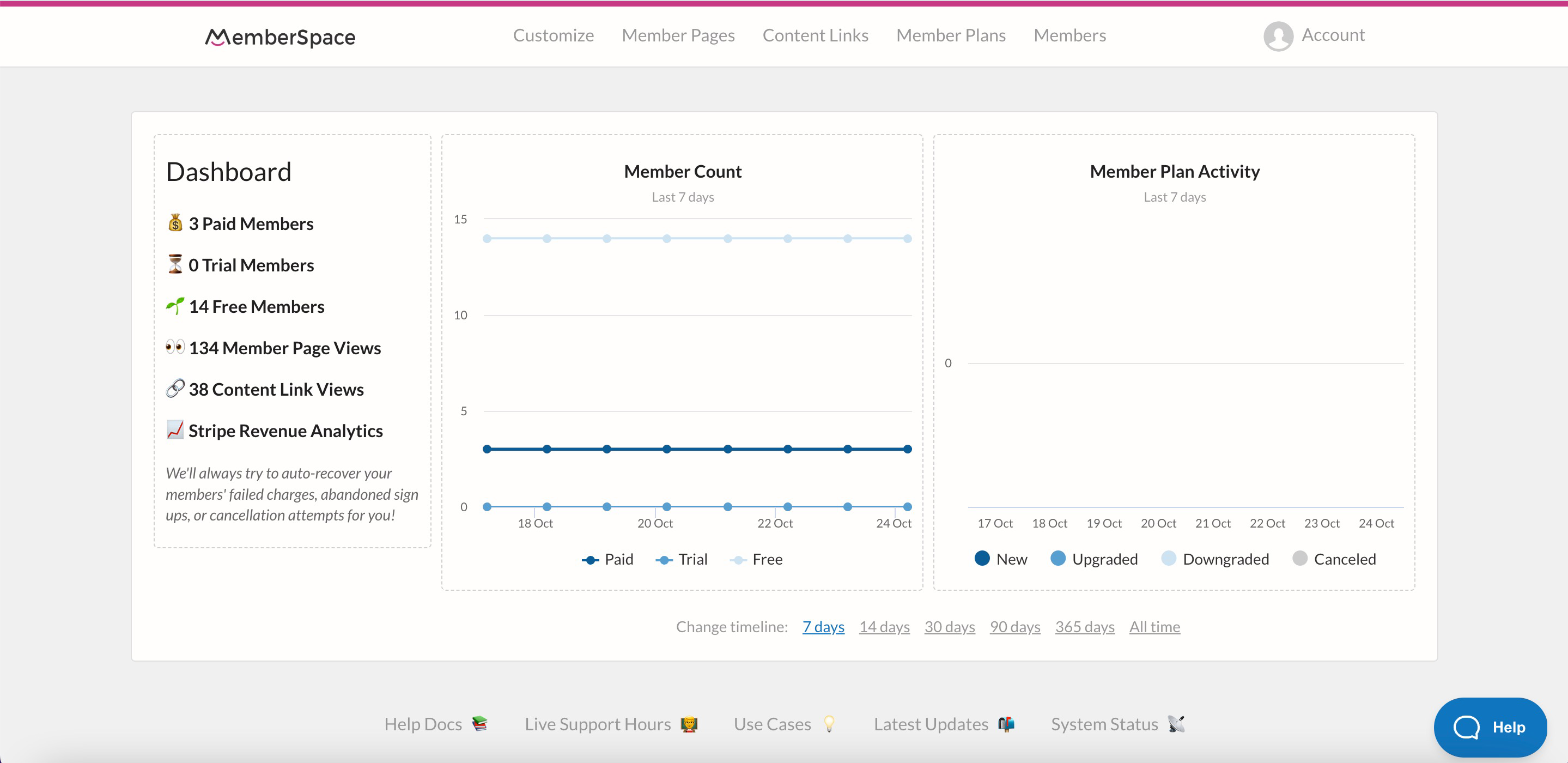Starting a business with no money isn’t easy, but it’s not impossible. So if you’ve ever dreamed of being your own boss and building your own business empire, you’re in the right place! In this guide, we’ll teach you how to become an entrepreneur with no money by working through 10 simple steps.
Nothing beats the exhilaration of making it in business on your own terms, and the benefits of entrepreneurship are plentiful. Aside from financial stability, perks include setting your own hours, creating a career that aligns with your values, and having complete autonomy over the direction your business takes.
Table of Contents:
- Finding your business niche
- Conducting market research
- Determining your target customer
- Making a business plan
- Figuring out what you can do for free
- Building a website
- Developing a marketing plan
- Seeking entrepreneurial resources
- Raising cash to get started
- Using low-cost solutions like MemberSpace
- Kickstarting your entrepreneurial journey
Becoming an entrepreneur in 10 steps
Spoiler alert: Building a membership site is the perfect solution to get started as an entrepreneur with limited funds because the set-up costs are low, and you can progress at your own pace.
Ready to learn how to become an entrepreneur with no money? Then let’s get to it!
1. Identify your business niche

If you’re reading this thinking, “I want to start a business but have no ideas,” there’s no need to panic. Many successful business owners were once in exactly the same position. The key lies in finding solutions to problems that fulfill the needs of people around you:
- Think about your personal strengths, interests, and hobbies, and consider ways you could monetize them. Low-cost ideas include:
- Check out resources like Product Hunt and Kickstarter to seek inspiration from existing entrepreneurial ideas.
- Ask your friends, family, and colleagues what frustrates them. Many a successful business was brought to life by founders who simply couldn’t find an existing solution to their needs:
- Ferruccio Lamborghini started out in the tractor business and only moved into manufacturing cars when he was disappointed with his Ferrari purchase.
- Reed Hastings founded Netflix after becoming annoyed at paying a $40 overdue fine after renting the Apollo 13 movie from Blockbuster.
- Donald Fisher started Gap because he couldn’t find a store in his local area that sold Levi’s jeans in his size.
2. Conduct market research

Knowing how to start a business with no money is only helpful if you know there will be a demand for your services or content. So, conducting market research before making a financial investment is essential. We know, because we experienced this first-hand when working out how to find a business niche ourselves.
Market research provides critical information about your customers, your business landscape, how your company will be perceived, and how much you can grow. There are typically three steps in conducting market research:
- Customer research – Asking the right questions confirms whether there is a genuine need for your products or services, and how much people would be willing to pay for them. Common techniques include using questionnaires, interviews, focus groups, and observational research.
- Competitor analysis – Establish who your competition will be, what they do, how well they are doing, what strategies they are using, and identify what you can do better.
- Industry research – Being prepared for any and all obstacles you may face is essential. Consider the current market trends, future projections, and what patents and licenses, etc. you’ll need to run your business.
3. Determine your target customer

Your market research will help you define your buyer persona and the market segments you want to target. You can segment your audience in multiple ways, including:
- Age
- Gender
- Location
- Job
- Income
- Purchasing habits
In the start-up process, many entrepreneurs fall into the trap of casting their net as wide as possible and hoping for the best. However, this is rarely a fruitful (or profitable!) strategy. All of your marketing efforts should be targeted. Defining your audience is vital in helping you:
- Create products and content they will be interested in (and ultimately pay for).
- Choose the right communication channels to reach them.
- Develop your product offering so you can pivot towards changes in consumer demand.
Remember that customer satisfaction is key, so always think about how you can satisfy your target customer in ways that your competitors can’t/don’t.
4. Make a business plan

When you’re starting a business with no money or experience, having a strategic business plan is essential. Entrepreneurs that are focused and prepared with a documented plan of action reach key milestones quicker and can steer their business more effectively as it grows.
Your business plan should summarize your mission and vision for the future, including short-term and long-term goals and the steps you’ll take to achieve them. Here is a template example for a typical business plan:
- Overall company summary – Including services offered, ownership info, and details about location and hours of operation, if relevant.
- Market analysis – A detailed breakdown of your consumer market and target audience.
- Competitor analysis – Rank your competitors, paying particular attention to how they manage their online presence, what digital platforms they use, their website SEO rankings, and any other information that will help you develop a plan to beat them.
- Strategy – List your unique selling propositions (USPs) and build out the marketing and sales techniques you’ll use to communicate them to your prospects.
- Milestone targets – Set goals for numbers of subscribers, downloads, sales, etc., and have a target for how long it will take you to achieve them.
- Management plan – Make a complete list of current and anticipated personnel needs and a thorough breakdown of roles and responsibilities. Even if you’re flying solo, this can help a lot with motivation and direction.
- Financial plan – Including budgets, start-up costs, asset value, and sales projections.
5. Figure out what you can do for free

When developing a strategy for how to become an entrepreneur with no money, it’s critical to keep your costs to a minimum in the early stages. So always be on the lookout for ways to kickstart your business at a minimal cost. Start by listing everything you need, then research free alternatives. Ask yourself questions like:
1. Can I build my own website on a WordPress alternative?
Although WordPress is a powerhouse platform, there are more intuitive solutions for beginners. For example, MemberSpace client elevatED opted for integrations utilizing Wix, while Good News chose Webflow integrations.
2. Can I design my own marketing materials?
There are many free tools you can use to create professional marketing materials and courses:
- Canva – A free, browser-based graphic design program with templates for guides, workbooks, and handouts.
- Unsplash and Pixabay – Libraries of royalty-free photos.
- Loom and Vidyard – Software that allows you to record and edit your own videos.
3. Can I run my own social media marketing and campaigns?
Social media management tools like Later, Sprout Social, Social Pilot, Planoly, and Loomly allow you to plan and schedule posts across various platforms, including Facebook, Instagram, TikTok, Twitter, and Youtube.
4. Can I use project management software rather than paying for a virtual or personal assistant?
Integrating with project management software like Notion blends your everyday work apps into an all-in-one workspace for your notes, tasks, wikis, and databases.
6. Build a website

Your website will be the lifeblood of your membership business, so you must ensure it’s thoroughly optimized. However, there’s much more to a top-performing site than just functionality. How a website looks, feels, and navigates could be the deciding factor in whether a customer chooses you over a competitor. Key considerations include:
- Color theme
- Photo and video content
- Ease of navigation
- Visual simplicity
- Keywording
- SEO
If you’re not a technical person, there are plenty of great platforms you can use that don’t require coding. Examples include Wix and Weebly. At MemberSpace, we believe anyone should be able to build and run a membership site without needing to hire a developer or have technical skills. So we’ve designed our software to be intuitive and straightforward so that non-technical people can launch and grow a membership business on any website.
7. Develop a marketing plan

Once you’ve got a great membership idea, a website, and a business plan, it’s time to think about the specifics of how you’ll get people to your site and market your offerings. Building a membership marketing plan typically covers nine key steps:
- Deciding on an open vs. closed strategy
- Crafting your offer
- Building an email list
- Building a sales funnel
- Driving traffic to your website
- Using social media
- Considering SEO
- Activating promotion
- Developing a marketing calendar
At every stage, it’s important to consider what benefits you offer your customers/members, and what makes your services or content unique and better than other available alternatives.
8. Look for entrepreneurial resources

There’s no one-size-fits-all guide on how to be an entrepreneur, but there are a heap of free resources you can utilize if you know where to look. Gaining knowledge and experience from others is a vital step in preempting challenges and hurdles, and can save you a considerable amount of time and money in the long run.
Professional development courses – There are several free online courses covering entrepreneurship, marketing, finance, and business management that can help you sharpen and maintain your skills.
Networking – Meeting with other entrepreneurs is a fantastic way to generate feedback and ideas. If you’re starting a newsletter or a course, for example, reach out to people who are already doing it and ask if they’d like to connect, offer advice, or cross-promote.
Community building – By creating your own paid community on a site like Circle, you can expand your membership business, grow your brand, and develop better relationships without relying too heavily on social media.
9. Raise cash to start your business

You’ve been thrifty in finding ways to start a business with no money and launch your membership site cost-effectively. But, you may still need additional funds to grow your business. Here are some options for raising capital:
- Friends and family – Donations and interest-free loans from people you trust can be a lifeline for your start-up. You may even choose to exchange funding for shares in your business.
- Crowdfunding – Crowdfunding platforms don’t just help you generate capital. They get you feedback and help build brand awareness.
- Apply for a small business loan – The US Small Business Administration (SBA) enables small businesses to receive loans of up to $50,000.
- Apply for a business line of credit – Although risking your credit score is not ideal, it may be your only choice if you don’t want to take on additional investors or partners.
- Look to small business grants and local funding opportunities – Federal, state, and local government programs exist to help entrepreneurs with low-interest loans, venture capital, and grants.
10. Use a low-cost solution like MemberSpace

By now, you’ve probably built up a relatively solid mental picture of how to start a business with no money, and some of the tactics you’ll use to achieve your goals. If you want to start profiting from your idea sooner rather than later, using a low-cost solution like MemberSpace is a fantastic way to jumpstart your membership business because you can integrate everything into a single platform, including managing your memberships, pricing, billing, cancellations, etc.
But you needn’t take our word for it. Our success stories pages are full of entrepreneurial success stories from real people just like you who have already benefited from our services and made their membership business dreams a reality.

Tools to kickstart your entrepreneurial journey
Here is a list of fantastic resources that are particularly helpful when starting a business with no money :
- Funding:
- Crowdfunding:
- Networking:
- Competitor reviews:
- Business forecasting:
- Events:
- Free Education:
Learning how to become an entrepreneur with no money is only the first step on your journey to business success, but we hope we’ve given you lots of valuable information to get you motivated.
Whether you want to start a membership site, online community, or sell digital products, MemberSpace’s team of experts and flexible membership software have all the essential tools, know-how, and integrations you need to get going and keep growing. Learn more and get started using MemberSpace for free today.




